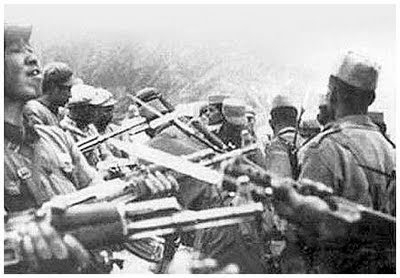Sino-Indian War
From Wikipedia, the free encyclopedia
Jump to: navigation, search
Page semi-protected
Sino-Indian War
Part of Cold War
India China Locator.png
The Sino-Indian War occurred between India and China.
Date 20 October[1] – 21 November 1962
Location South Xinjiang (Aksai Chin) and Arunachal Pradesh (South Tibet, North-East Frontier Agency)
Result Chinese military victory.
Territorial
changes No significant territorial change compared with prior to the war.
China controls Tibet excluding Tawang and area south of McMahon Line (South Tibet) and retains Aksai Chin area (de facto); India controls North-East Frontier Agency (South Tibet, Arunachal) area (de facto).
Belligerents
India
India
People's Republic of China
China
Commanders and leaders
India Brij Mohan Kaul
India Jawaharlal Nehru
India V. K. Krishna Menon
India Pran Nath Thapar People's Republic of China Zhang Guohua[2]
People's Republic of China Mao Zedong
People's Republic of China Liu Bocheng
People's Republic of China Lin Biao
People's Republic of China Zhou Enlai
Strength
10,000–12,000 80,000[3][4]
Casualties and losses
1,383 Killed[5]
1,047 Wounded [5]
1,696 Missing[5]
3,968 Captured[5] 722 Killed.[5]
1,697 Wounded[5][6]
This article contains Chinese text. Without proper rendering support, you may see question marks, boxes, or other symbols instead of Chinese characters.
This article contains Indic text. Without proper rendering support, you may see question marks or boxes, misplaced vowels or missing conjuncts instead of Indic text.
The Sino-Indian War (Hindi: भारत-चीन युद्ध Bhārat-Chīn Yuddh), also known as the Sino-Indian Border Conflict (simplified Chinese: 中印边境战争; traditional Chinese: 中印邊境戰爭; pinyin: Zhōng-Yìn Biānjìng Zhànzhēng), was a war between China and India that occurred in 1962. A disputed Himalayan border was the main pretext for war, but other issues played a role. There had been a series of violent border incidents after the 1959 Tibetan uprising, when India had granted asylum to the Dalai Lama. India initiated a Forward Policy in which it placed outposts along the border, including several north of the McMahon Line, the eastern portion of a Line of Actual Control proclaimed by Chinese Premier Zhou Enlai in 1959.
The Chinese launched simultaneous offensives in Ladakh and across the McMahon Line on 20 October 1962, coinciding with the Cuban Missile Crisis. Chinese troops advanced over Indian forces in both theatres, capturing Rezang la in Chushul in the western theatre, as well as Tawang in the eastern theatre. The war ended when the Chinese declared a ceasefire on 20 November 1962, and simultaneously announced its withdrawal from the disputed area.
The Sino-Indian War is notable for the harsh conditions under which much of the fighting took place, entailling large-scale combat at altitudes of over 4,250 metres (14,000 feet).[7] This presented enormous logistics problems for both sides. The Sino-Indian War was also noted for the non-deployment of the navy or air force by either the Chinese and Indian sides.





.jpg)




 3:16 AM
3:16 AM
 zimbio
zimbio
















0 comments:
Post a Comment